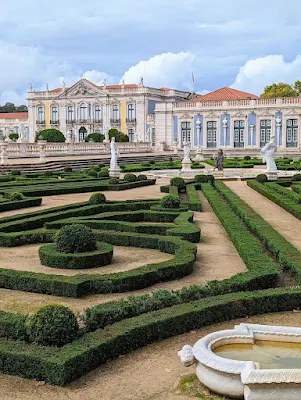Have you heard of Queluz Palace? Lisbon and surrounding towns like Sintra are home to a number of beautiful palaces. Pena Palace, the Moorish Castle, and Quinta da Regaleira are three of the area's most popular attractions.
You may be wondering: Is Queluz Palace worth visiting on a trip to Lisbon? Read on to learn more about doing a day trip to Palácio Nacional e Jardins de Queluz. I would argue that this palace rich in history and sumptuous architecture is a true Lisbon hidden gem.
Queluz Palace History
How to Get From Lisbon to Queluz Palace?
How Much Does it Cost to Visit Queluz Palace?
Highlights of the Queluz Palace Tour
The Throne Room
The Music Room
The Queluz Palace Music Room is also pretty cool. The centerpiece of the room is a historic Clementi pianoforte. Apparently, the wife of João VI used this room as her hand-kissing room and reception area.
The Queluz Palace Music Room is one of the oldest rooms in the palace and was designed by architect Mateus Vicente de Oliveira.
The Skylight Room
The Skylight Room was a sort of office space with light streaming in through a skylight in the roof. We learned that in this room preparations were made for Napoleon to visit Queluz Palace. However, Napoleon instead invaded Portugal and the monarchy decamped to Brazil.
Portugal was effectively governed from Brazil for a period of about 15 years.
The Hall of Tiles
The Hall of Tiles at Queluz Palace is another spectacular space. Colorful scenes on the walls represent the four seasons with azulejos. Below this, you'll find blue and white tiles that are focused on hunting.
The Don Quixote Room
Highlights of the Queluz Gardens
Sculptures by John Cheere
Keep a special eye out for sculptures by John Cheere. Cheere was an 18th century English sculptor working in London. The group of about 15 Cheere sculptures at Queluz Palace comprises the largest collection of the artist's work outside of England.
The sculptures are helpfully labeled on the free map of the palace and gardens that comes with your ticket.
The Tiled Canal
The Tiled Canal (aka Tiles Channel) is one of the most spectacular parts of the Queluz Palace Gardens. The Tiled Canal comprises 150 meters of tiled walls, with a sluice of muddy water going through. (I assume the water was muddy because it was raining on the day we visited.)
You can definitely see some 18th Century motifs running through the tiles. For example, you'll see people wearing pointy, tri-cornered hats.
The tiles are multicolored on the side closest to the palace and there are blue azulejos on the other side depicting more seafaring themes.
If you walk up the staircase by the Tiled Canal, you can get a fantastic view over the beautiful blue Queluz Palace.
Around The Robillion Staircase
The Robillion Staircase was carved from a single stone that led from the private quarters of King Pedro III and Queen Maria I to the Robillion Pavilion which housed the cages where the royal family would keep lions, monkeys, and other exotic animals.
I recommend making your grand entrance into Queluz Gardens using the Robillion Staircase. Make sure to watch your step. If it's rainy, the staircase can be quite slippery.
The Labyrinth Garden
The Labyrinth or Old Maze Garden at Queluz Palace is beautiful with well-coiffed hedges. It's hard to get lost here since the hedges are quite low and you can easily see how to get around any obstacles.
Around the Botanical Garden
En route to the Botanical Garden, stop and have a look at The Palm Game. This is a sort of 18th century tennis court.
The signature feature of the Queluz Palace Botanical Garden are the four greenhouses growing pineapples. Some of the monarchs who lived here actually personally tended the fruit since pineapple was a limited and much loved delicacy at the time.
The botanical garden is a bit jarring to visit. A major highway runs right outside the walls so it can be quite loud here.
🔎 Looking for other ideas of where to go for a full day out from Lisbon? Why not plan a wine tasting tour of Setúbal or take a walk on Carcavelos Beach?























.jpg)
